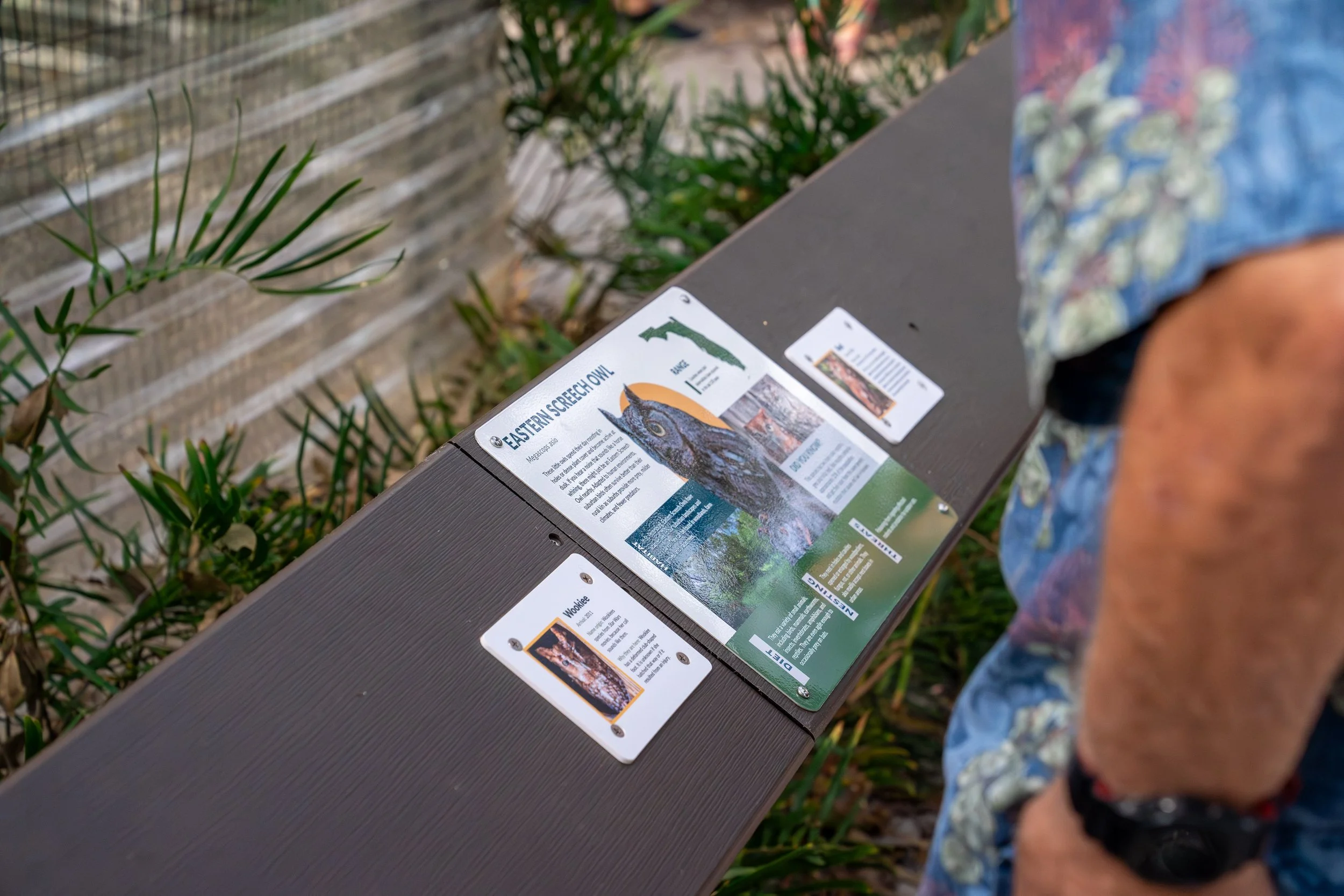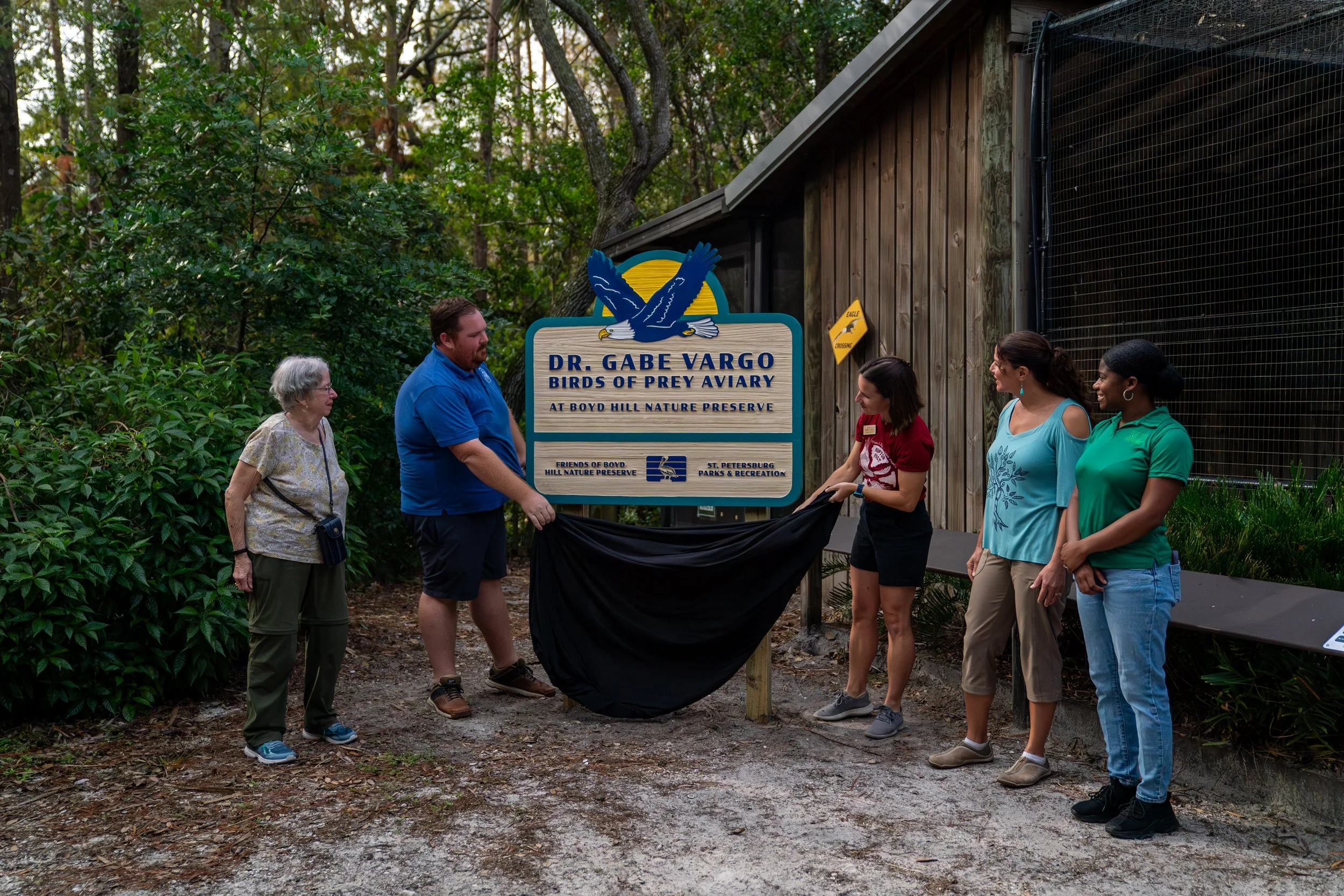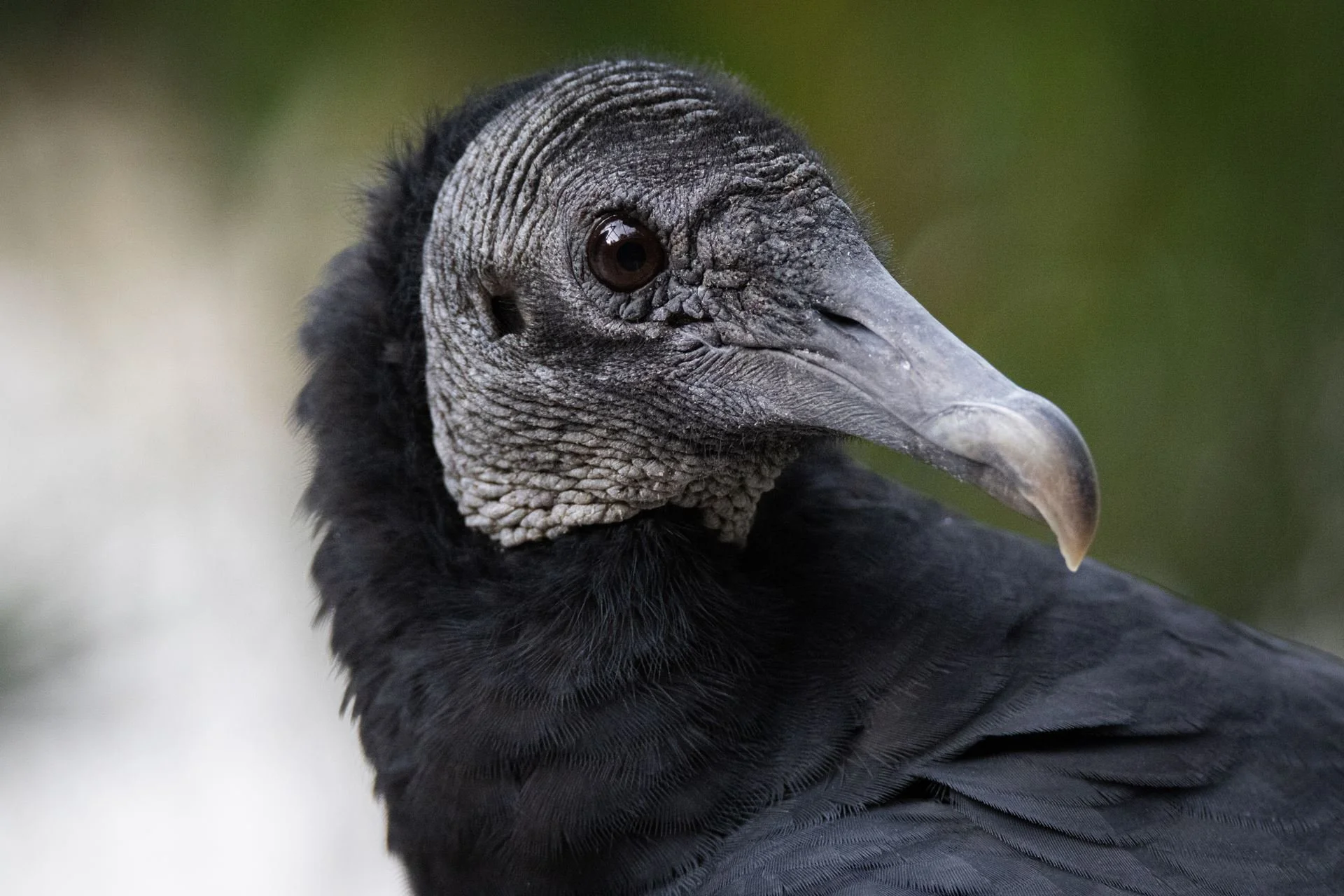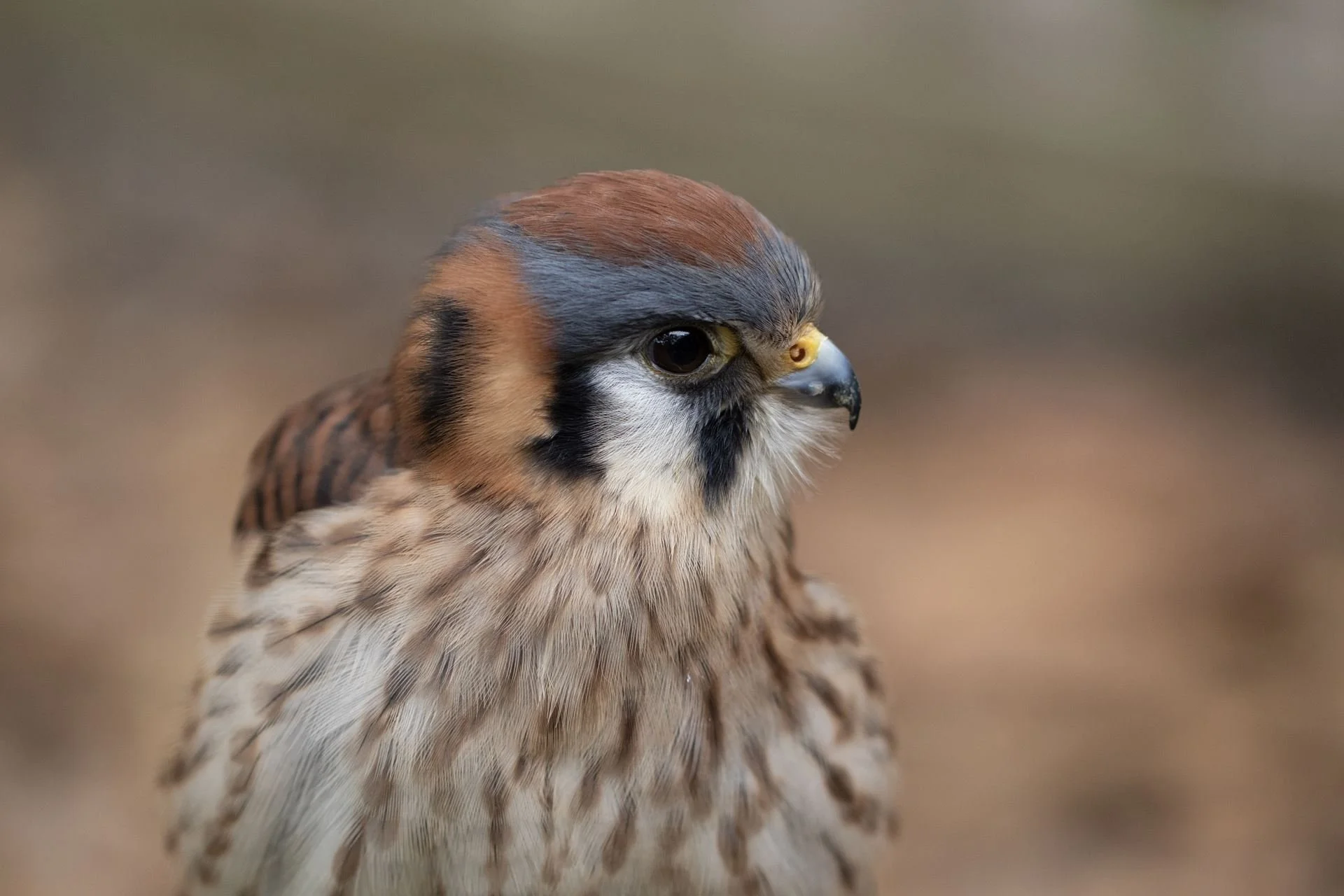
Dr. Gabe Vargo
Birds of Prey Aviary
Dr. Gabe Vargo Birds of Prey Aviary
Established in 1986, the City of St. Petersburg’s Birds of Prey Program provides lifelong homes for around 20 non-releasable raptors at Boyd Hill Nature Preserve. These owls, vultures, hawks, eagles, and more live under the care of Friends of Boyd Hill staff and volunteers, who ensure they receive a quality diet, daily enrichment, and the chance to participate in educational programs. A true partnership between the Friends of Boyd Hill and the City of St. Petersburg, the program shares responsibility for the birds’ care, shelter, and veterinary needs. Each bird is carefully vetted by licensed rehabilitators and, once accepted, Boyd Hill becomes their forever home—where they inspire visitors to connect with and protect wildlife in their own communities.

Birds of prey Program
Visitors to Boyd Hill can see amazing raptors up close and learn about their vital role in the ecosystem. These non-releasable owls, vultures, hawks, and eagles have found lifelong homes here, where they inspire people to care for wildlife in their own communities. Through educational programs and outreach, these birds serve as powerful ambassadors, connecting visitors to the natural world while enjoying the expert care and enrichment provided by Friends of Boyd Hill.
DR. GABE VARGO
Photo credit: J. Clayton
Meet the Birds
of Prey
ABIAKA
Bald Eagle
(Haliaeetus leucocephalus)
Abiaka was hatched in December 2009 and fell from his nest on Honeymoon Island, severely injuring his right wing. Two primary tendons that control the outer half of the wing were severed, rendering him incapable of flight. He weighs approximately 6 pounds and is anticipated to live 30-40+ years in captivity.
SALVADOR DALI
Northern Crested Caracara
(Caracara cheriway)
Salvador Dali arrived is believed to have hatched in 2016. He calls BHNP his home because, after being struck by a car, he lost sight in his left eye. 'Sal' is fully flighted and very inquisitive. Caracaras do not reside in Pinellas County, but Florida has a small, stable population.
MYSTIC
Barred Owl
(Strix varia)
Mystic came to BHNP in September 2009. She was already 10 years old at the time. Mystic has a malformed right wing and a chronic toe injury on her right foot. While she has some flight ability, it is not enough to hunt successfully in the wild. She is considered “retired,” and no longer goes out on programs.
RED
Screech Owl
(Megascops asio)
Red arrived to BHNP as a one-year-old in the summer of 2016 as a human imprint, along with Brave. We were told that Red was surrendered by an individual that did not have proper permits to have him.
EDGE
Red-Tailed Hawk
(Buteo jamaicensis)
Edge came to Boyd Hill in the summer of 2023 as a juvenile. She was struck by a car in North St Pete and suffered damage to her right eye, making her permanently blind and non releasable. She is named after Rosalie Edge who was a conservationist and created Hawk Mountain Sanctuary.
PUGSLEY
Turkey Vulture
(Cathartes aura)
Pugsley arrived at BHNP in 2001 as a juvenile. He had a broken radius (small bone at the leading edge of the wing) that did not heal properly, thus limiting his ability to fully extend his wing. How the injury occurred is unknown. However, this robbed him of the ability to glide and soar, essential to vultures in their search for food.
Nyx
Turkey Vulture
(Cathartes aura)
Nyx came to us in the summer of 2015 at about 7 months of age. She is named after the Greek goddess of the night. She had suffered a wing injury to her left wrist, which had subsequently become infested with maggots and left her unable to regrow her outer primary flight feathers.
ALDO
Barred Owl
(Strix varia)
Aldo came to BHMP in 2019. He was found tangled in fishing line, near the water in Tampa. Busch Gardens performed surgery to remove the tip of his right wing. They believe he was a young bird, approximately a year old, when he was found.
BRAVE
Screech Owl
(Megascops asio)
Brave was approximately three months old in 2016 when he arrived at our program. He came as an imprint, meaning he does not know what it means to be an owl since he was not raised by them. He got his name due to his brave and curious personality when he arrived as a very young bird.
RUSTY
Screech Owl
(Megascops asio)
Brave was approximately three months old in 2016 when he arrived at our program. He came as an imprint, meaning he does not know what it means to be an owl since he was not raised by them. He got his name due to his brave and curious personality when he arrived as a very young bird.
CADE
American Kestrel
(Falco sparverius)
Cade came to our program in the summer of 2023 as a juvenile. When he was a chick he was illegally taken from the wild and raised by humans. By the time he was taken to a rehabilitator he had become imprinted to humans, and suffered from physical development issues due to nutritional deficiencies from an improper diet. Cade is named after Tom Cade, Founding Chairman of the Peregrine Fund.
HOWI
Black Vulture
(Coragyps atratus)
Howi is believed to have hatched in 2013. She was originally named ‘Howard’ after the preserve employee who discovered her on Boyd Hill Nature Preserve property acting sickly. A past wing fracture which calcified and healed improperly has limited her ability to soar to find food.
ARCHIMEDES
Great Horned Owl
(Bubo virginianus)
Archimedes is a female who came to us in September of 2012 from the Busch Wildlife Sanctuary in Jupiter, FL. She is named after the ancient Greek mathematician. We know little of “Archie’s” history, but her injury results from a gunshot wound to the right wing. The wound was so severe that her wing had to be partially amputated.
WOOKIE
Screech Owl
(Megascops asio)
Wookie is a red morph who arrived in 2011 as a chick. She can be identified by her deformed right foot which may have been broken and healed in a deformed manner, or it could be the result of a birth defect. This prohibits her from grasping and holding prey effectively.
D’ARTAGNAN “DART”
Short-Tailed Hawk
(Buteo brachyurus)
D’Artagnan, or “Dart,” for short, arrived in June 2021 with a permanent wing injury. Short-tailed hawks are not native to this part of Florida, but rather to south Florida, coastal Mexico, and much of South America. Dart is a dark morph more common in Florida, but in other areas short-tailed hawks can be found with a white breast coloring.
CARSON
Short-Tailed Hawk
(Buteo brachyurus)
Carson came to BHNP as an adult in March 2019. Carson is habituated or imprinted on humans. Someone kept her illegally and treated her as a pet bird. Kestrels and the rest of our birds of prey are protected under the Migratory Bird Treaty Act, making it illegal to have them without proper permits.

Aviary Volunteer Opportunities
For Volunteer Opportunities Please Apply Via the Link Below


















